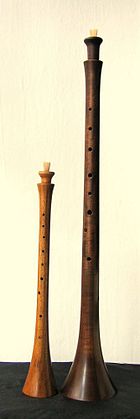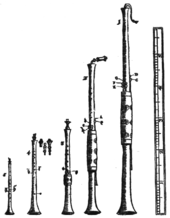Shawm
![]()
This article is about the double-reed instrument shawm, for other meanings see shawm (disambiguation). In particular, the Martin trumpet, which became known primarily through the workers' movement, is also called a shawm.
The shawm, also shalmay, shalmey, ciaramella, kalamaia, is a woodwind instrument with a double reed and a conically bored tube. The shawm usually has seven front finger holes. A thumbhole for the left thumb may also be present. Shawms developed in the 15th century with a range extended into lower registers were called pommer.
The sound is very loud, sharp and nasal, especially in the low register. The range is 1½-2 octaves, with overblowing once into the octave. The instruments are playable chromatically by means of forked fingerings with the exception of the minor second to the lowest note. A pirouette (lip rest) is often used on this direct-blown reed instrument to relieve the lips.
The shawm has Asian antecedents, called sornay in Iran and Central Asia, zurna in Turkey, and appeared in Europe in the Middle Ages. In the Renaissance it was made in c/f tuning in the garklein, sopranino, soprano, alto, tenor and bass pitches common to recorders. The bass shawm is unwieldy and has to be blown with a lot of air.
With the development of the oboe in the Baroque era the shawm was completely ousted from court music and concerts. In some regions of the western Mediterranean and Brittany, however, shawms continue to be used as folk instruments to the present day (in part revitalized, see bombarde, tarota, autbòi, ciaramella, piffero, sopila). Non-European, especially oriental shawm instruments were and are widespread.
Since the middle of the 20th century shawms have again been built and played according to historical models. In addition to playing music from the Middle Ages and Renaissance, they are also occasionally used in folk and modern music.

Two reconstructed Renaissance shawms: sopranino and soprano

Shawms (from the Syntagma musicum by Michael Praetorius)
Search within the encyclopedia